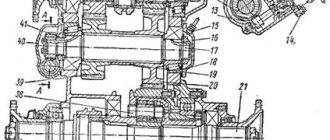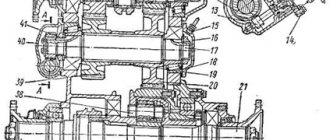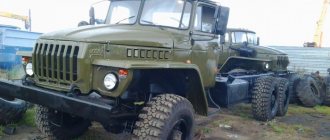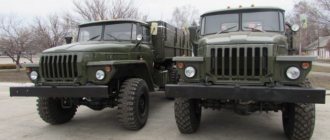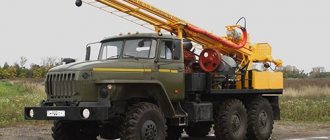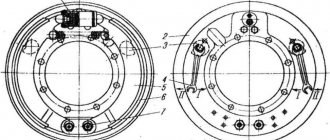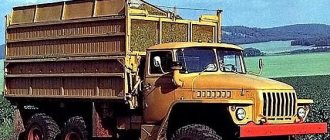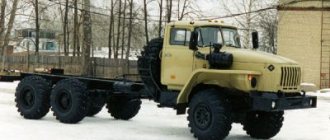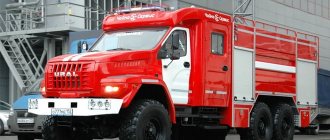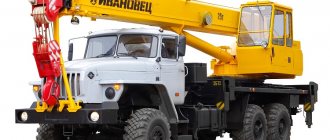Vehicles for fighting fires in residential and industrial premises, as well as in open spaces, are built on the basis of trucks. The Fireman Ural began to be produced on the basis of the 375 gasoline chassis. Subsequently, 2 and 3-axle vehicles with an economical and powerful diesel engine began to be used.
Advantages of fire fighting equipment on the Ural chassis
The fire truck chassis cannot be chosen at random. "Ural" is suitable for the stated purposes due to a number of advantages:
- Prepare for harsh conditions. "Ural" is produced in a region with a harsh continental climate, this car is not afraid of either heat or bitter frosts, and the lack of an adequate road will not be a big problem either.
- Reliability. The constant presence of the chassis on the market for over forty years indicates the complete indestructibility of the base and its readiness to serve forever.
- Low cost . “Ural” is produced within the country, production is located relatively close, so delivery of the chassis to equipment is cheap, and there are no inflated customs duties either.
Miass fire trucks are heavy tank trucks with a mandatory telescopic ladder. The models differ from each other mainly in the tank capacity and partly in the set of fire-fighting equipment.
How long does water last in a fire truck?
Standard ACs are equipped with water tanks, the volume of which is no more than 3000–4000 liters. This amount of fire extinguishing agent can extinguish a fire within 5–8 minutes. In this regard, it is necessary to find an external source for filling the tanks. Such sources include lakes, rivers, wells, etc.
By the way. With the development of the technical industry, models with a capacity of up to 8000 liters appeared on the fire truck market. This volume is quite enough to put out a fire without using a fire hydrant.
Specifications
The dimensions and characteristics of the machines depend on the capacity of the tank, the model of the base chassis and additional equipment. A car of the same model can be equipped with different power plants and gearboxes. For example, on an AC 10.0 40 vehicle, built on the basis of the Ural-4320, a 230-horsepower YaMZ-6565 diesel engine or a 285-horsepower YaMZ-536 engine can be used. In this case, the maximum speed of the installation does not exceed 80 km/h (with a full load).
Parameters of the AC-6.0-40 vehicle, based on the Ural-5557 chassis:
- length - 8690 mm;
- width (along the tire sidewalls) - 2500 mm;
- height - 3280 mm;
- base - 3525 mm;
- rear bogie base - 1400 mm;
- approach angle - 35°;
- departure angle - 27°;
- rear overhang length - 2275 mm;
- tire size - 425/85R21;
- curb weight of the vehicle - 17485 mm.
The car uses a 4-stroke diesel engine YaMZ-65654 with a turbocharger, developing a power of 230 hp. With. The motor is equipped with an electronic control unit and complies with Euro 4 requirements.
Device
When creating a fire truck, the main elements of the Ural base chassis (engine, transmission, chassis) remain unchanged. Some elements can be modernized. For example, an additional heat exchanger is introduced into the cooling system of the power unit or a new radiator with an increased area is installed. This modification ensures long-term operation of the engine in the summer. When building machines, a modular principle is used, which makes it possible to re-equip the equipment.
To supply water from a third-party container, a centrifugal pump is used, the design of which includes a gas-jet vacuum apparatus.
The device is powered by exhaust gases, which are additionally used to heat the pump body and water tank. Numerous modifications are made to the chassis electrical system, including the installation of an additional cabin, light signaling and electronic controls.
An all-metal compartment for additional members of the combat crew is attached to the base chassis cabin. The standard rear wall of the cabin is removed completely or partially. Above the rear axles there are tanks for water and foam concentrate. For the manufacture of tanks, steel with a special coating that resists corrosion is used. Along the tanks there is a structure that forms compartments for installing fire-fighting equipment. Additional devices are also located on the roof of the superstructure.
A power take-off gearbox is installed on the base chassis gearbox, which is controlled from the cab. A cardan transmission is mounted between the output shaft of the gearbox and the centrifugal pump, which can consist of several parts with intermediate supports. If the pumping station is located at the rear, then the control rods for the vehicle’s clutch and throttle assembly or fuel injection pump rack are also output there.
The fire-fighting equipment includes generator sets, a retractable lighting mast, and portable spotlights. It is possible to place emergency rescue equipment with a hydraulic drive.
Pump equipment
Tankers based on the Ural chassis are equipped with NTsPN pumps (normal pressure centrifugal fire pump) produced by the Ural Special Equipment Plant. It serves to supply water and aqueous solutions. The pump is made in various designs, which determine the functionality of the equipment. For example, the model NTsPN40/100 V1T can be deciphered as follows:
- 40 – water supply in liters per second;
- 100 – pressure in meters;
- B1 – built-in vacuum system with an electric drive with semi-automatic control, which provides protection against unforeseen situations;
- B2 – vacuum system with electric drive only with manual control, in which protection against force majeure situations is not provided, and the pump will continue to operate as long as the “Start” button is pressed;
- T – tachometer, which shows at what frequency the shaft rotates.
The speed and efficiency of extinguishing a fire depends on the correct operation of pumping equipment. Therefore, only persons certified to know its structure and operating rules are allowed to operate the pump.
The pump is installed in closed compartments of the car while ensuring a positive temperature. The rigidity of the frame where the pump is installed must ensure the absence of resonances during pump operation.
Before starting the pump, make sure that all valves and taps are closed. Connect the hoses, supply water to the pump, turn on the drive and open the valve. Set the required pressure at the pump outlet. During operation of the pump, it is necessary to constantly monitor the readings of instrumentation. Stop the pump when the water in the tank is completely consumed.
The pump is a reliable piece of equipment and will provide long and efficient service with proper care and maintenance.
- No foreign objects should get into the pump cavity;
- it is necessary to monitor the condition of the lubrication system;
- It is unacceptable to leave the pump with water poured into it, especially in an unheated room;
- check the oil level in the crankcase.
Maintenance of the pump coincides with the maintenance of a fire truck: daily maintenance, maintenance 1 and maintenance 2. All detailed explanations for installation, operation, and maintenance of pumping equipment are contained in the pump operating instructions.
Fire and rescue vehicle PSA 2.0-40/4 Ural-NEXT 4320-6951-74E5 with CMU ANT 7.5-2 (load capacity 3 tons)
| Engine YaMZ 53613-10 | |
| engine's type | Four-stroke compression ignition |
| Number and arrangement of cylinders | 6, in-line |
| Cylinder displacement, cm3 | 6650 |
| Compression ratio | 17,5 |
| Maximum power, kW | 228 (312 hp) |
| Maximum torque, N*m | 1221 |
| Fuel | Diesel |
| Technical characteristics of the fire and rescue vehicle PSA 2.0-40-4 Ural-NEXT 4320-6951-74E5 | |
| Crew cabin and driver's cabin | |
| Type | Salon type. Combined with the base chassis cab; ensures visual contact between all members of the combat crew without the use of special technical means In front - two seats with a driver, in the back - four seats (crew compartment) Autonomous compartment heater |
| Seats | The squad leader's seat in the base chassis cabin and the combat crew seats are equipped with individual seats with a reclining headrest, a mount for compressed air breathing apparatus. The seat cushion covers for firefighters and the squad commander are made of breathable, non-toxic, softened material. Under the seat cushions there is a box (locker) for storing fire-fighting and emergency equipment. The total width of seats for crew members is 1800 mm. Seat depth 400 mm. |
Features of firefighters AC Ural
The fire crews of the Ural Automobile Plant always rely on a significant supply of water - the volume of the tank varies between 3-8 tons. The main fire extinguishing agent is supplemented with a foaming agent, for which a separate container with a volume of 180-480 liters is installed. All models are all-wheel drive, there are 4x4 and 6x6 wheel configurations, the engine of the Yaroslavl Motor Plant YaMZ-236 or YaMZ-238 drives the colossus. Water supply is provided by pumps NTsPN 40/100 or NTsPK 40/100-4/400. The curb weight of the vehicle ranges from 12 to 21 tons, the combat crew usually consists of 6 people.
A characteristic feature is the mandatory installation of a retractable staircase, which allows you to quickly reach the upper floors of the building. Otherwise, the equipment of fire trucks based on the Ural should be considered standard - special compartments are allocated for fire extinguishing equipment, equipped in accordance with the rules.
“Priority” made “Ural NEXT” a rescuer and firefighter
Specializing in the development and production of fire-fighting vehicles from Miass, at the request of the Russian Ministry of Emergency Situations, began production of the fire-rescue vehicle APS-3.0-40/4, based on the high-capacity Ural NEXT chassis with a 6x6 wheel arrangement. The vehicle is designed to extinguish fires and carry out emergency rescue operations, including dismantling building structures, eliminating the consequences of road accidents and rescuing people on water bodies. Behind the serial cabin there is an additional frame-panel crew cabin with a separate entrance (the frame is steel, the interior and exterior are made of fire-resistant impact-resistant composite plastic). APS-3.0-40/4 ensures delivery to the site of a fire or accident of personnel in the amount of 6-7 people, a supply of water (3,000 l) and foam concentrate (180 l), as well as an extensive set of rescue and fire-technical equipment weapons. In the rear compartment there is a powerful two-stage fire pump NTsPK-40/100-4/400 (up to 6000 l/min) with an automatic computer foam dosing system, as well as a CAFS compression foam supply system with a capacity of 2400 l/min of compressed air. The fire and rescue "Ural-NEXT" is also equipped with a hydraulically driven crane (maximum lifting capacity 3 tons, maximum boom reach 6.8 m), a telescopic lighting mast (2x90 W), a front electric winch (pulling force 8 tons) and a generator (6KW/220volt) driven by an autonomous diesel engine.
Purpose ATs-6.5 Ural 4320-1112-61E5
The AC-6.5 tank truck on the Ural 4320 chassis is designed for transportation on general roads and short-term storage of light petroleum products with a density of no more than 0.83 t/m3. The tank truck must be moved empty or with a completely filled tank; moving with a tank that is not completely filled is not allowed, since a shift in the center of gravity of the load during movement can lead to the AC overturning. Tank trucks are a measure of total capacity. Special equipment consists of the following main parts:
- tanks
- pumping unit
- fire-fighting equipment and means for removing static electricity
Capacitive technology
The fire tanker belongs to the class of tank equipment. In our country, tank trucks are produced in Miass. Therefore, buyers will never have problems with components, and the prices for tanks are quite reasonable. Tankers are made of high-quality steel with anti-corrosion treatment or fiberglass. Let's figure out how the AC works.
The tanker truck has a tank and a foam tank. The tank holds up to 15 cubic meters of water, its mass is very large, so the manufacturer’s priorities were to lighten the tank itself as much as possible, while providing it with the necessary rigidity. This was achieved using the shape of the structure. The tank has an oval or square shape with cut corners. Due to the rigidity of the structure, it is possible to produce thinner walls and, therefore, provide less weight.
At the top of the container there is a hole and a neck with a hinged lid. Through it you can refill with water and carry out preventive inspections and repairs. Under the cover there is a control tube. Water comes out through it when it is poured into a container. Breakwaters are installed lengthwise and crosswise inside the tank. They prevent the fluid from swinging inside the tank and contribute to vehicle stability when driving on the road.
It is interesting that in the options for the northern regions, ACs are equipped with heating of water in the tank. There is a pipe installed inside through which hot exhaust gases pass.
The pump compartment of the water tank also has heating, which is designed on the same principle.
Popular models of firefighters AC Ural
The variety of fire fighting vehicles based on the Ural includes more than ten models, but the main difference between them is the capacity of the water tank.
The following are in high demand:
- ATs 3.0 - 40 (43206) - a relatively compact model, adapted for movement on any road conditions and capable of single-handedly fighting fires of significant size, allows the pump to be installed directly in the cabin;
- ATs 5.5 – 70 (5557) has an increased supply of fire extinguishing agents and a 6x6 wheel arrangement; it is distinguished by the presence of heating in the cabin for more comfortable work in the cold season;
- ATs 8.0 - 40 (4320) C - the heaviest type of firefighting "Ural", carries 8 tons of water, and is in demand for extinguishing fires over a large area.
Prices and analogues
The cost of new cars starts from 4 million rubles. The ATs-6.0-40 installation is estimated by the manufacturer at 6.45 million rubles. Decommissioned fire engines based on the Ural, produced in the 80s, can be purchased for 350-500 thousand rubles. Assembly technology from the early 2000s will cost 0.9-1.2 million rubles. Cars built on gasoline chassis are practically not found on sale.
Similar equipment is mounted on KamAZ all-wheel drive chassis. There are modifications built on the basis of the KamAZ-4308 truck, equipped with a rear drive axle. Until 2015, fire engines were produced based on ZIL trucks. Due to the liquidation of the plant, chassis supplies ceased.
Tanks and fuel tankers Ural
Varieties and assortment
We offer different types of special equipment. This includes fuel tankers, tank trucks (food, industrial water, oil field), vacuum machines, gas condensate collection units, fuel and oil tankers. They differ:
- purpose;
- chassis type;
- wheel formula;
- engine type and power;
- cabin shape;
- dimensions of the onboard platform;
- volume and design of the tank;
- number of sections;
- type of self-priming pump;
- fuel tank capacity;
- additional equipment.
Manufacturing and sales
You can buy tanks and fuel tankers from us inexpensively, taking into account their operating conditions. You can purchase special equipment on lease. If the required machine is in stock, you will immediately receive it at your disposal. If the model is not available, it will take time to produce it. The special equipment presented in the catalog is covered by a warranty.
If there is no suitable configuration on the website, you can order retrofitting of the tank or tanker with the necessary equipment. For example, heating a container or installing a dispenser box. Certain types of modifications to special equipment are presented in the section.
Features and where to use
Tanks are divided by type of cargo - oil field, fire, methanol and water tankers. They are designed for transportation and short-term storage of liquid cargo. The engine power of the machine reaches 420 hp. With. The volume of the liquid tank is from 4.5 to 20 m³. A variety of models allows you to perform different tasks.
Fuel tankers are used for transportation and mechanized supply of fuel. The tanks are made of structural carbon steel (grade 09G2S). Suction and delivery hoses are placed on both sides of the tank in special canisters. The pumping unit is mounted on a special bracket. There is an inspection window at the neck of the tank that allows you to monitor the liquid level in the tank. Special equipment is equipped with a platform for servicing the machines and a ladder for climbing onto it.
All flammable special equipment is equipped with additional equipment (ADR). The necessary information is presented in the thematic section.
No. 10. Refuelers
Refueling trucks are used for transportation, temporary storage and mechanized supply of fuel with a density of up to 0.83 t/m³. Special equipment differs in tank design and configuration. On the website you can buy fuel tankers of various modifications.
Varieties and assortment
We offer different types of special equipment. They differ:
- chassis type;
- wheel formula;
- engine type and power;
- cabin shape;
- platform dimensions;
- volume and design of the tank;
- number of sections;
- presence of an observation window;
- type of working pump;
- fuel dispensing measuring device;
- fuel tank capacity;
- location of the shopping center;
- additional equipment.
Manufacturing and sales
You can buy fuel tankers from us inexpensively, taking into account their operating conditions. You can purchase special equipment on lease. If the required machine is in stock, you will immediately receive it at your disposal. If special equipment is not available, it will take time to manufacture it. The cars presented in the catalog are covered by a warranty.
If there is no suitable configuration on the website, you can order the tanker to be retrofitted with the necessary equipment. For example, installing an additional compartment to separate different types of fuel or replacing the fuel tank. Certain types of modifications to special equipment are presented in the section.
Features and where to use
Refueling trucks are used for filling/emptying tanks with their own or third-party pump, pumping fuel, transporting fuel, and refueling armored vehicles. The chassis of special equipment is manufactured taking into account the requirements for the transportation of flammable liquids. The tanker is equipped with sand boxes and two powder fire extinguishers.
Ural tanker trucks are distinguished by increased cross-country ability. They are ideal for delivering fuel to hard-to-reach areas and field airfields.
Fire trucks Ural
The fire tanker is designed to deliver personnel, fire-fighting equipment and equipment to the site of a fire, carry out fire extinguishing operations and rescue operations.
A fire hose vehicle is designed for transporting fire hoses, mechanized laying and cleaning of main hose lines, extinguishing fires with water or air-foam jets using stationary or portable fire monitors.
The fire pumping station is designed to supply water through main fire hoses directly to portable fire monitors or to fire trucks with subsequent supply of water to the fire and create a reserve supply of water near the site of a large fire.
| No. OTTS | Commercial name | Type, modification of vehicle | Vehicle chassis |
| TC RU E-RU.MT39.00131.Р1И1 | Fire tanker ATs-6.0-40 Ural | 485A-10 | Ural 5557-1151-60 Ural 5557-1151-62 Ural 5557-1151-70 Ural 5557-1151-72 Ural 5557-1151-74 Ural 5557-4151-78 Ural 5557-4151-80 Ural 5557-4151-82 Ural 5 557 -4551-78 Ural 5557-4551-80 Ural 5557-4551-82 |
| TC RU E-RU.MT39.00131.Р1И1 | Fire tanker ATs-6.0-70 | 485A-10A | Ural 5557-1151-60 Ural 5557-1151-62 Ural 5557-1151-70 Ural 5557-1151-72 Ural 5557-1151-74 Ural 5557-4151-78 Ural 5557-4151-80 Ural 5557-4151-82 Ural 5 557 -4551-78 Ural 5557-4551-80 Ural 5557-4551-82 |
| TC RU E-RU.MT39.00131.Р1И1 | Fire tanker ATs-6.0-40 | 485A-14 | Ural 4320-1951-60 Ural 4320-1951-62 Ural 4320-1951-70 Ural 4320-1951-72 Ural 4320-1951-74 |
| TC RU E-RU.MT39.00131.Р1И1 | Fire tanker ATs-6.0-70 | 485A-14A | Ural 4320-1951-60 Ural 4320-1951-62 Ural 4320-1951-70 Ural 4320-1951-72 Ural 4320-1951-74 |
| TC RU E-RU.MT39.00131.Р1И1 | Fire tanker ATs-5.5-40 Ural | 485A-15 | Ural 5557-1151-60 Ural 5557-1151-62 Ural 5557-1151-70 Ural 5557-1151-72 Ural 5557-1151-74 |
| TC RU E-RU.MT39.00131.Р1И1 | Fire tank truck ATs-5.0-40 Ural | 485A-19 | Ural 5557-1151-60 Ural 5557-1151-62 Ural 5557-1151-70 Ural 5557-1151-72 Ural 5557-1151-74 Ural 5557-4151-78 Ural 5557-4151-80 Ural 5557-4151-82 Ural 5 557 -4551-78 Ural 5557-4551-80 Ural 5557-4551-82 |
| TC RU E-RU.MT39.00131.Р1И1 | Fire tanker ATs-5.5-70 | 485A-19A | Ural 5557-1151-60 Ural 5557-1151-62 Ural 5557-1151-70 Ural 5557-1151-72 Ural 5557-1151-74 Ural 5557-4151-78 Ural 5557-4151-80 Ural 5557-4151-82 Ural 5 557 -4551-78 Ural 5557-4551-80 Ural 5557-4551-82 |
| TC RU E-RU.MT39.00131.Р1И1 | Fire hose vehicle AR-2 Ural | 485R-01 | Ural 4320-1151-61 Ural 4320-1151-63 Ural 4320-1151-71 Ural 4320-1151-73 Ural 4320-1151-75 Ural 4320-4151-79 Ural 4320-4151-81 Ural 4320-4151-83 Ural 4 320 -4551-79 Ural 4320-4551-81 Ural 4320-4551-83 |
| TC RU E-RU.MT39.00131.Р1И1 | Fire pumping station PNS-100 | 485N-01 | Ural 4320-4151-79 Ural 4320-4151-81 Ural 4320-4151-83 Ural 4320-4551-79 Ural 4320-4551-81 Ural 4320-4551-83 |
| TC RU E-RU.MT39.00131.Р1И1 | Fire pumping station PNS-110 | 485N-01A | Ural 4320-4151-79 Ural 4320-4151-81 Ural 4320-4151-83 Ural 4320-4551-79 Ural 4320-4551-81 Ural 4320-4551-83 |
UZST fire truck catalog
Using a fire hydrant
A fire hydrant is a device that allows you to connect equipment that supplies water to a fire to a water supply. All fire water supply networks have hydrants.
The opening and closing of hydrants, as well as the connection of fire hoses to them, is carried out using fire pumps. The center wrench is a tool for opening the hydrant valve.
The method of supplying the active substance from hydrants depends on the water supply pressure:
- Low (water is collected using columns from the network through hydrants, and then transferred to hand trunks).
- High (liquid is supplied through hoses from hydrants).
Attention! Hydrants must undergo technical inspections twice a year. This helps to increase the service life and prevent possible breakdowns in the system.
